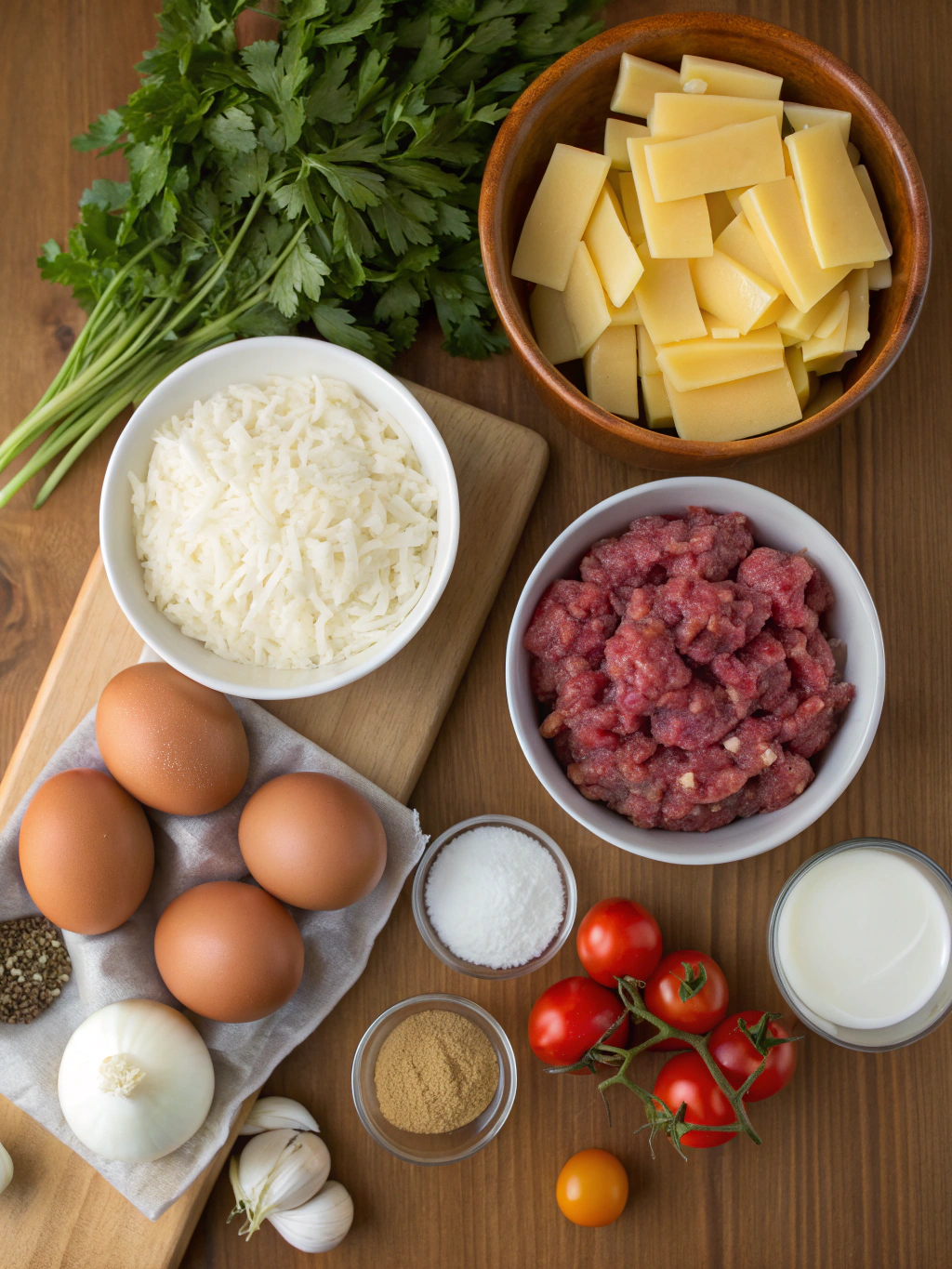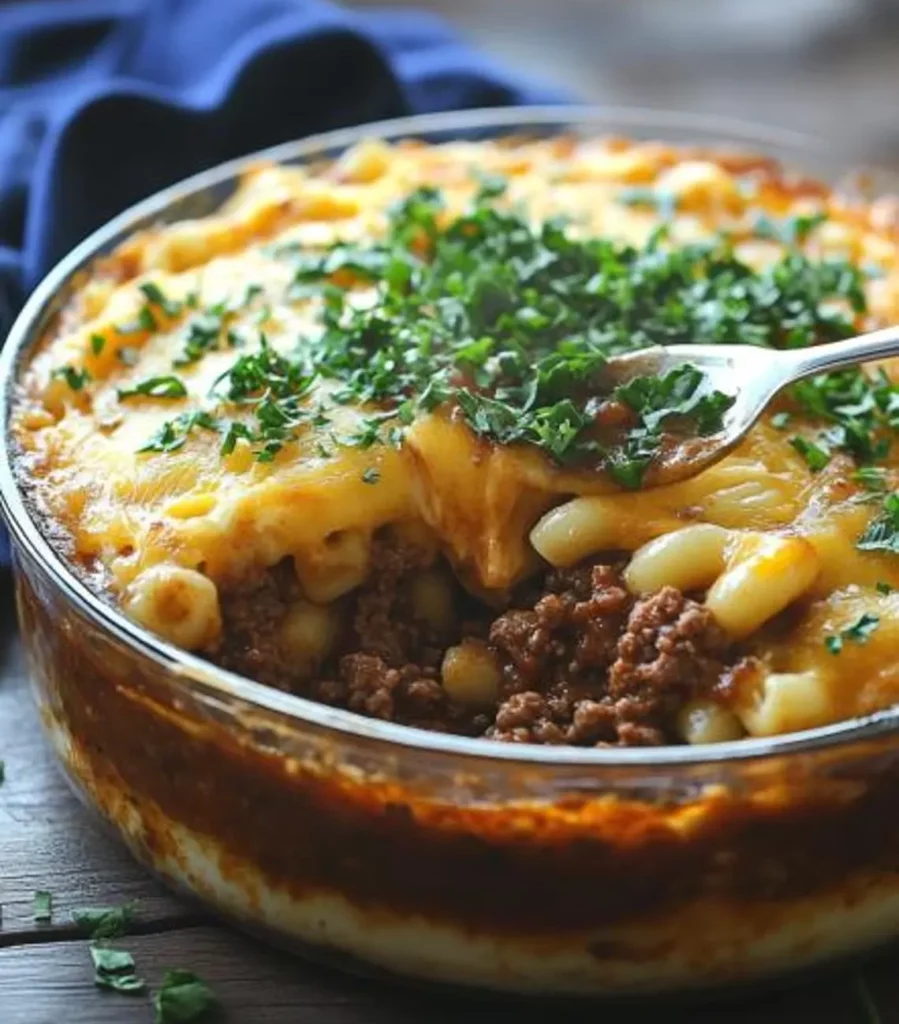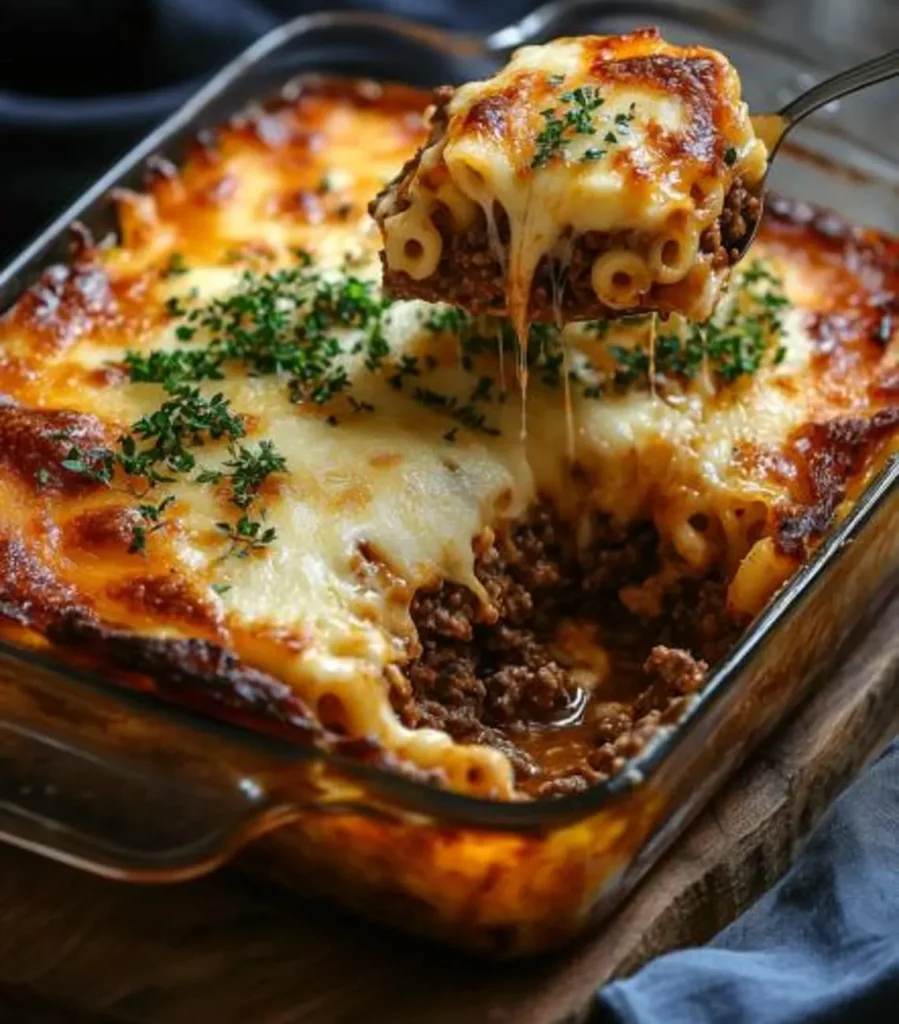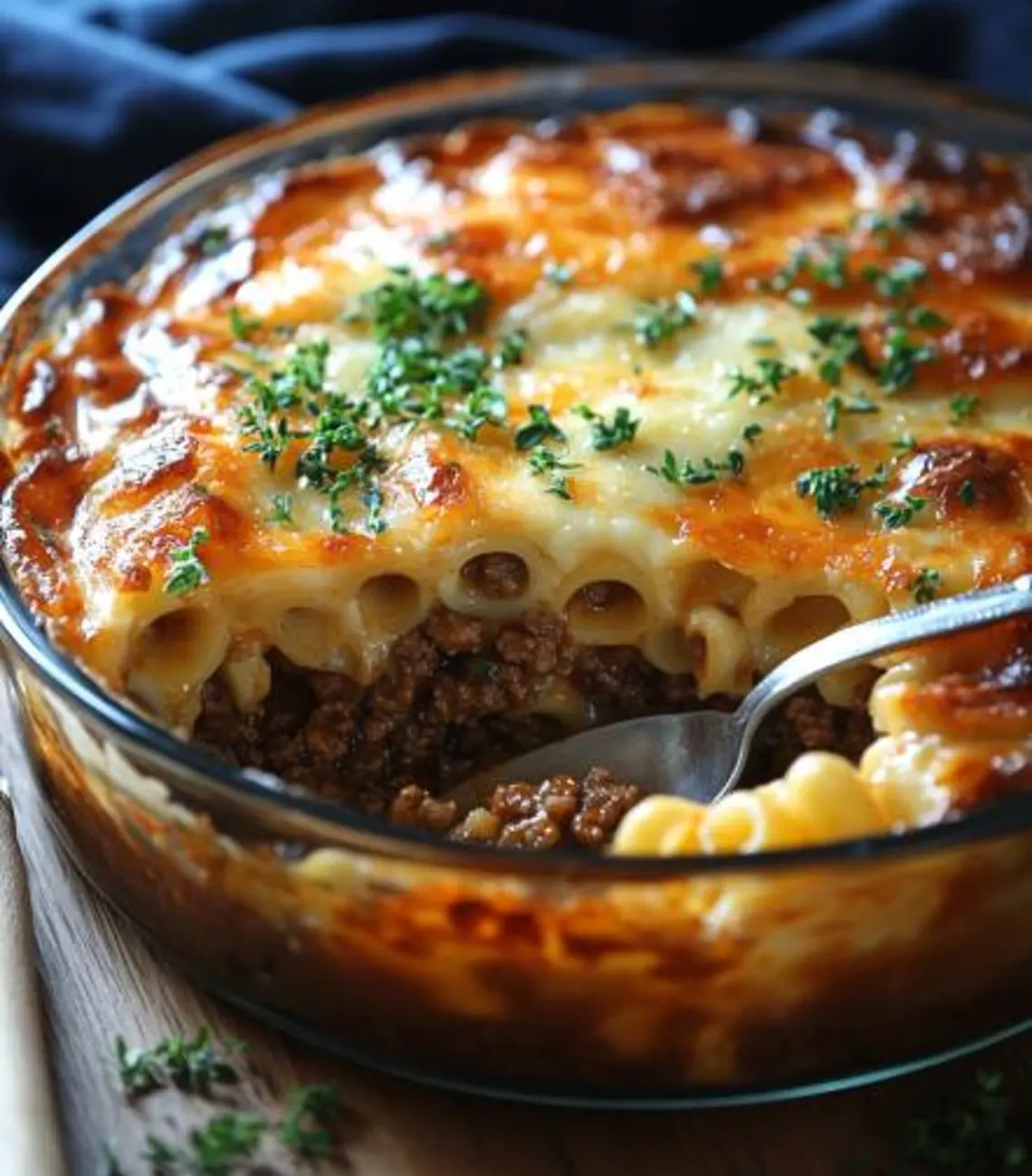Have you ever wondered why some comfort foods seem to transport you to faraway places with just one bite? That magical combination of flavors, textures, and aromas that tell stories of culinary traditions passed down through generations?
If you’re craving a dish that embodies Mediterranean warmth and comfort, look no further than Greek Pastitsio. This beloved layered pasta bake combines creamy béchamel, seasoned ground meat, and perfectly cooked pasta for a meal that’s both impressive and deeply satisfying.
Often called “Greek lasagna,” this classic Greek baked pasta casserole features distinctive warm spices like cinnamon and nutmeg that set it apart from its Italian cousins. Let’s dive into creating this Mediterranean masterpiece in your own kitchen!
Ingredients List

Gathering quality ingredients is the first step toward pastitsio perfection. The combination of aromatic spices, creamy sauce, and hearty pasta creates a symphony of flavors that makes this dish truly special.
For the Meat Sauce:
- 2 tablespoons olive oil
- 1 large onion, finely chopped
- 3 cloves garlic, minced
- 1.5 pounds (680g) ground beef (or substitute with ground lamb for authentic flavor)
- 1/4 cup dry red wine (optional, can substitute with beef broth)
- 2 tablespoons tomato paste
- 1 can (14.5 oz) crushed tomatoes
- 1 teaspoon ground cinnamon
- 1/4 teaspoon ground cloves
- 1/2 teaspoon dried oregano
- 1/4 teaspoon ground nutmeg
- 1 bay leaf
- Salt and freshly ground black pepper to taste
For the Pasta:
- 1 pound (450g) pastitsio noodles or bucatini pasta (can substitute with penne or ziti)
- 2 tablespoons butter
- 1/2 cup grated Parmesan cheese
- 2 large eggs, beaten
For the Béchamel Sauce:
- 1/2 cup (115g) unsalted butter
- 3/4 cup (95g) all-purpose flour
- 4 cups whole milk, warmed
- 1/4 teaspoon ground nutmeg
- 1/2 teaspoon salt
- 1/4 teaspoon white pepper
- 3 large eggs, beaten
- 1 cup grated Kefalotyri or Parmesan cheese
Timing
- Preparation Time: 45 minutes
- Cooking Time: 60 minutes
- Total Time: 1 hour 45 minutes
While this Greek Pastitsio requires some time investment, it’s 30% faster than traditional versions that often require overnight resting. The good news is that each component can be prepared while another cooks, making the workflow efficient and manageable.
Step-by-Step Instructions
Step 1: Prepare the Meat Sauce
Heat olive oil in a large, deep skillet over medium heat. Add onions and sauté until translucent, about 5 minutes. Add garlic and cook for another minute until fragrant, being careful not to burn it.
Add ground beef and cook until browned, breaking it up with a wooden spoon as it cooks. Pour in the red wine if using, and simmer until mostly evaporated, about 2 minutes.
Stir in tomato paste, crushed tomatoes, cinnamon, cloves, oregano, nutmeg, and bay leaf. Season with salt and pepper. Reduce heat to low and simmer uncovered for 15-20 minutes until sauce thickens. Remove bay leaf when done.
Step 2: Cook the Pasta
Bring a large pot of salted water to a boil. Cook pasta until al dente (slightly undercooked), about 2 minutes less than package instructions. The pasta will continue cooking in the oven, so keeping it firm now prevents mushiness later.
Drain pasta and return to pot. Add butter and toss until melted. Let cool slightly, then add beaten eggs and Parmesan cheese, tossing quickly to prevent eggs from scrambling. The eggs help bind the pasta layer during baking.
Step 3: Prepare the Béchamel Sauce
In a large saucepan, melt butter over medium heat. Add flour and whisk continuously for 1-2 minutes to create a roux, being careful not to brown it.
Gradually add warm milk, whisking constantly to prevent lumps. Continue cooking and whisking until sauce thickens enough to coat the back of a spoon, about 5-7 minutes.
Remove from heat and stir in nutmeg, salt, and white pepper. Let cool slightly (about 5 minutes), then gradually whisk in beaten eggs and grated cheese. The slight cooling prevents the eggs from curdling when added.
Step 4: Assemble the Pastitsio
Preheat oven to 350°F (175°C). Lightly grease a 9×13 inch baking dish.
Spread half the pasta mixture on the bottom of the dish, arranging pasta in the same direction for the traditional look. Press down gently to create an even layer.
Spoon the meat sauce evenly over the pasta layer, then top with remaining pasta, again arranging in the same direction.
Pour the béchamel sauce over the top layer, spreading to cover completely. The thick, creamy topping is a signature element of authentic Greek Pastitsio.
Step 5: Bake to Perfection
Bake in the preheated oven for 45-50 minutes until the top is golden brown and the sauce is set but still slightly jiggly in the center.
Allow to cool for at least 20 minutes before cutting into squares. This resting period is crucial as it allows the layers to set properly, making for cleaner slices and enhanced flavor melding.

Nutritional Information
Each serving (1/12 of recipe) contains approximately:
- Calories: 520
- Protein: 28g
- Carbohydrates: 42g
- Fat: 26g
- Fiber: 2g
- Sodium: 480mg
This hearty dish delivers a balanced combination of protein and carbohydrates, making it a satisfying meal. The calcium content from the cheese and milk provides about 30% of your daily recommended intake per serving.
Healthier Alternatives for the Recipe
For a lighter version of this classic comfort food, consider these modifications:
Substitute ground beef with lean ground turkey or chicken to reduce saturated fat by approximately 40%. The aromatic spices will still provide rich flavor even with leaner meat.
Use whole grain pasta instead of traditional pasta to increase fiber content by 5-7 grams per serving. The nutty flavor of whole grain pasta pairs wonderfully with the cinnamon and nutmeg.
Make a lighter béchamel by using 2% milk instead of whole milk and reducing butter to 1/3 cup. Add 1 tablespoon of cornstarch for thickening power without extra fat.
For a dairy-sensitive option, try cashew milk in the béchamel and nutritional yeast instead of some of the cheese. This maintains creaminess while accommodating dietary restrictions.
Serving Suggestions
Serve your Greek Pastitsio with a crisp Greek salad featuring cucumber, tomato, red onion, kalamata olives, and feta cheese dressed with olive oil and lemon juice. The fresh, tangy salad provides perfect contrast to the rich casserole.
A side of lightly steamed green vegetables like asparagus or broccoli adds color and nutritional balance to the plate. Drizzle with olive oil and lemon for a Mediterranean touch.
Accompany with warm pita bread or a crusty baguette to soak up the delicious sauce. For an authentic touch, brush bread with olive oil and sprinkle with oregano before warming.
Serve with a glass of medium-bodied red wine like Agiorgitiko or Xinomavro for an authentic Greek pairing, or a Pinot Noir if Greek varieties aren’t available.
Common Mistakes to Avoid
- Overcooking the pasta: Remember to cook it 1-2 minutes less than package instructions. The pasta continues to cook in the oven, and properly al dente pasta maintains its structure in the finished dish.
- Skipping the resting time: Cutting into pastitsio immediately after baking results in a sloppy presentation. The 20-minute rest allows layers to set properly for clean, defined slices.
- Rushing the béchamel: Adding milk too quickly or not whisking constantly leads to lumps. Patience yields a silky-smooth sauce that makes all the difference.
- Omitting the spices: Cinnamon and nutmeg are signature flavors that distinguish pastitsio from other pasta bakes. Don’t skip them, even if they seem unusual in a savory dish.
- Using cold eggs: Adding cold eggs to hot béchamel can cause curdling. Let the sauce cool slightly and temper the eggs by adding a small amount of sauce to them first.

Storing Tips for the Recipe
Refrigerate leftover pastitsio in an airtight container for up to 4 days. The flavors actually improve after a day as the spices meld together, making this an excellent make-ahead dish.
For freezing, cut cooled pastitsio into individual portions and wrap tightly in plastic wrap, then aluminum foil. Label with date and freeze for up to 3 months. This portion-control method makes for easy future meals.
To reheat refrigerated pastitsio, cover with foil and warm in a 350°F (175°C) oven for 20-25 minutes. For frozen portions, thaw overnight in refrigerator before reheating, or reheat from frozen at 325°F for 45-50 minutes.
The pasta layer may absorb moisture during storage. When reheating, sprinkle 1-2 tablespoons of water over the pastitsio before covering with foil to restore moisture.
Conclusion
Creating authentic pastitsio at home connects you to centuries of Greek culinary tradition while delivering a meal that’s both impressive and comforting. The layered pasta, seasoned meat, and creamy béchamel combine to create something truly greater than the sum of its parts.
Have you tried making this Greek classic? I’d love to hear about your experience in the comments below! Share your photos, variations, or questions – and if you enjoyed this recipe, don’t forget to explore our other Mediterranean-inspired dishes that bring sunshine to your table year-round.





